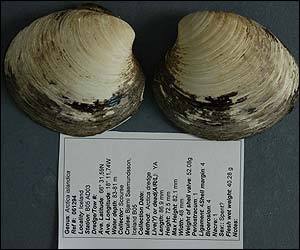A British scientific team discovered the 405-year-old clam, named after the Chinese dynasty and not the former Liberal Democrat leader, at the bottom of the ocean, and hope its longevity will reveal the secrets of ageing.

|
| ©n/a |
| The oldest creature ever |
So significant is the find that Help The Aged have awarded a £40,000 grant to the team to investigate how the molusc, born when Queen Elizabeth I was on the throne and William Shakespeare was writing The Merry Wives of Windsor, has survived over the centuries.
The record-breaking shellfish, 31 years older than the previous oldest animal, another clam, was caught last year when scientists from the Bangor University School of Ocean Sciences were dredging the seabed north of Iceland.
The Arctica islandica was among a haul of 3,000 empty shells and 34 live molluscs taken to the laboratory.
Unfortunately, by the time its true age had been established Ming was already dead. But the scientists aged the 3.4in clam from its shell which like trees has a layer or ring of growth for every year that the animal has been alive.
The shell only grows in summer when the water is warmer and the plankton it eats is plentiful.
Each year a layer as thin as 0.1mm is laid down.
When Dr Alan Wanamaker, one of the researchers, cut the clam's shell in half, he counted 405 lines.
The clam far outlives other venerable animal species such as the Galapagos tortoise (the oldest known specimen of which lived for 176 years) and the bowhead whale (130 years).
Its age makes the ocean quahog a remarkable environmental sentinel, because the exact thickness of each layer in its shell is determined by the state of its environment at the time it grew.
"It was a large animal so I expected it to be old," said Dr Wanamaker. "But we never expected it to be so extraordinarily old. I knew that the previous record was 374 years and so when I realised it was older I called a colleague to verify it."
The shellfish was dredged as part of a study into climate change over the centuries but because of its extreme age it is now also being investigated by a team of biologists looking into ageing.
"Al rushed up to my office to announce that they had found a record-breaker," said team member Prof Chris Richardson. "If, in Arctica islandica, evolution has created a model of successful resistance to the damage of ageing, it is possible that an investigation of the tissues of these real life Methuselahs might help us to understand the processes of ageing."
Richard Faragher, a gerontologist at Brighton University working with the Bangor team, said: "Most of what we know about the ocean quahog is what it tastes like. We need to find out how it retains muscle strength, remains cancer-free and keeps its nervous system intact over such a long period of time."
It must have come as an unpleasant shock to the Iceland clam to be scraped up after more than four centuries of doing virtually nothing - the quiet, safe life of a clam, according to Faragher, could explain its longevity.
"It has the most boring life," he said. "It even has a low rate of reproduction."
Perhaps not surprisingly, the sexual capacity of the 405-year-old clam is described by the scientists as "spent".
"It may be that reproduction has given up by that age," said Prof Richardson.
Mike Foster, a spokesman for the research arm of Help the Aged, said: "This discovery is not just a curiosity - it is a chance to discover how it remains fit and healthy for hundreds of years."
According to the Guinness Book of Records, the existing record for the longest-lived animal belongs to a 220 year old Arctica clam collected in 1982 from American waters.
Unofficially, the record belongs to a 374 year old Icelandic clam in a German museum.
The oldest ever...
Tree, bristlecone pine: USA: 4,844 (years)
Fish, lake sturgeon: 154
Mammal: bowhead whale: 130
Human: Jeanne Calment: 122
Macaw: 106
Elephant: 78
Horse: 62
Japanese salamander: 55
Herring gull: 49
Bat: 32
Dog: 24
Rabbit: 18



I knew before I read the article that this clam of great longevity did not survive the observation process. If we have great accomplishments perhaps it is best not to call attention to it. We might not live through the acclaim.